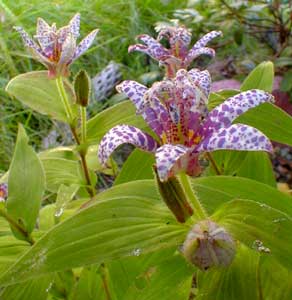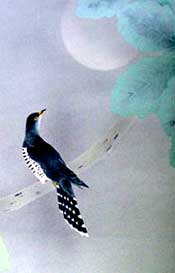
'Miyazaki' Hototogisu Lily;
or, Hairy Toadlily;
or, Speckled Toad Lily
"Wide from the world, a stolen hour
We claim, & none may know
How love blooms like a tardy flower
Here in the day's after-glow."
-Hart Crane
(1899-1932)
(1899-1932)
Tricyrtis hirta 'Miyazaki' is named for the Miyazaki Agricultural Experiment Station, Miyazaki University, Japan, where this cultivar was developed.
The same agricultural station produced other forms of the speckled toad lily, with differing leaves. 'Miyazaki' itself has shiny evenly light-green or yellow-green leaves, but 'Miyazaki Gold' has gold-edged green leaves, & 'Moonlight' has entirely golden leaves. There are additional named cultivars, but some of them appear to be renamed Miyazaki introductions.
The species is native of Japan & was formerly named T. japonica. It is commonest in Honshu, Shikoku, & Kyushu, but is also found outside of Japan, in Korea & China.
 Its Japanese name is Hototogisu, which is borrowed from the name of the Mountain Cuckoo, the plaintive cry of which is sometimes heard on the soundtracks of samurai films. Its call sounds like a sad lament & often symbolized a tragic death of someone still young, such as a young warrior, or the living death of a girl sent to the pleasure district.
Its Japanese name is Hototogisu, which is borrowed from the name of the Mountain Cuckoo, the plaintive cry of which is sometimes heard on the soundtracks of samurai films. Its call sounds like a sad lament & often symbolized a tragic death of someone still young, such as a young warrior, or the living death of a girl sent to the pleasure district.Some say it is the sound of the recently dead crying out in melancholy longing to return to their families & homes. But the Mountain Cuckoo simultaneously symbolized refined taste, especially in color design of embroidered layers of kimonos. It is frequently mentioned in Japanese poetry, much as in the west poets are enamored of the Nightingale.
The Mountain Cuckoo usually makes his call during early summer evenings, whereas the toadlily blooms in autumn, so the association is a thin one. The flower bares the bird's name because the blooms' markings resemble the breast-markings of the Mountain Cuckoo.
'Miyazaki' toadlily is a foot shorter than the wild species, reaching only about twenty-four inches of height or less. The species is more uprightin its growth. 'Miyazaki' when young & not too weighty in its stem production can also grow strongly upright, but as it matures it will eventually be more arching, & is in general more compactly leafed than the wild form.
It blooms late-late summer or the start of autumn, & will continue to bloom up to late-autumn if frosty mornings are few. The orchid-like blooms are about as big around as a quarter, occurring singly or in groups of two or three, close to the stems within the leaf axils.
In color they are white to palest lilac, thick with dark lavender freckles. The wild form has splotches of purple rather than speckling. Each bloom has three sepals & three petals for a total of six tepals looking so identical that it appears as a six-petalled flower. Because toadlily flowers are small, & only showy upon close examination, it is always recommended they be planted close to a path where they can be appreciated close-up.
It loves part sun to part shade & will even do nicely in full shade. We placed ours in dappled shade at the dripline of a witchhazel at the foot of "pulpit hill." Because so many of the Jack-in-the-Pulpits & all the triliums are gone before autumn, it is nice to have this late-blooming perennial for the sake of late-season "action" in the shade garden. They can survive in gardens down to Zone 4, but would need to be placed in more sunlight to insure bloom before first frost.
Apart from requiring a persistently moist well-draining soil, & so needing deep watering if there are droughty summers, the many cultivars of T. hirta demand little or no attention, despite an exotic & delicate appearance. In some situations they can even be a bit aggressive, & have naturalized as invasive plants in Massachusetts.
The cultivars fortunately are more restrained than the species per se, & even if they do self-seed, they will not cause problems in the garden. Where seedlings to appear, they should be transplanted quickly into well-cared for pots, or directly to permanent locations, as once they are established in the ground, they truly dislike being dug up & moved.
If there is more than one cultivar in close proximity, they will inevitably hybridize; any such seedlings should be designated "Miyazaki hybrids." They will have blooms variously marked & colored & of unpredictable merits, though mostly they'll look pretty darned nice.
We also have in another shade garden T. formosana 'Samurai' with variegated leaves, & a more spread-out rather than clumping disposition. It spreads rapidly by rhizomes, but T. hirta is not rhizomitous, so its spread is comparatively slow, or more tightly clumping.